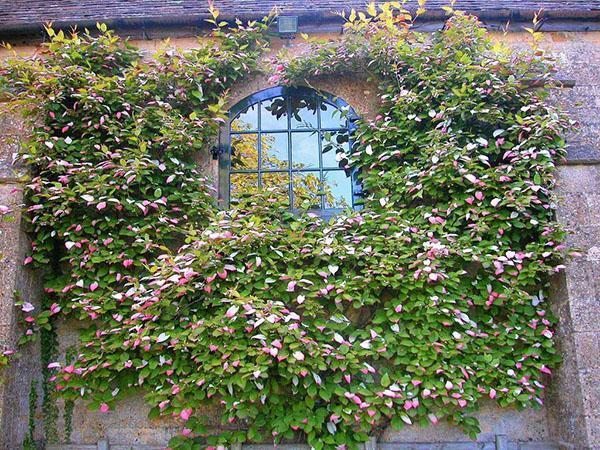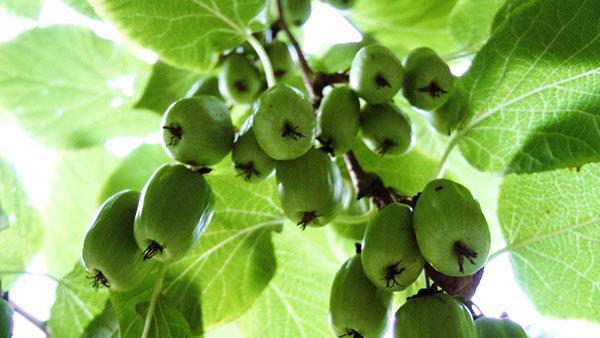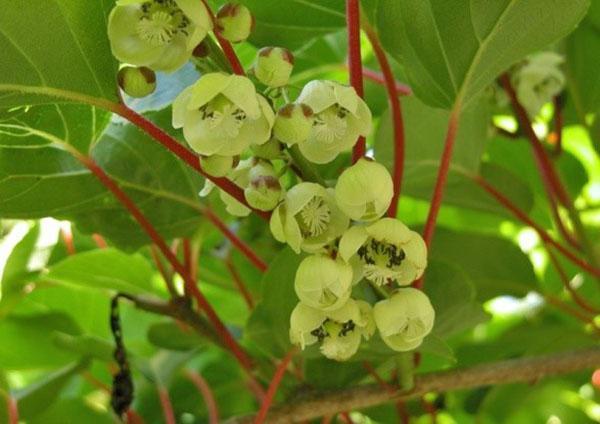To achieve a large harvest of actinidia, we learn to properly care for it
 Actinidia is becoming more and more popular in garden stores, the cultivation and care of which is very simple, and the result is pleasant. From a shrub, you can collect at least 20 kg of delicious fruits, depending on age. What is it? In order not to be verbose, let's say that one of the varieties of this plant is kiwi. So what should be the care of a miraculous relative to get a big harvest?
Actinidia is becoming more and more popular in garden stores, the cultivation and care of which is very simple, and the result is pleasant. From a shrub, you can collect at least 20 kg of delicious fruits, depending on age. What is it? In order not to be verbose, let's say that one of the varieties of this plant is kiwi. So what should be the care of a miraculous relative to get a big harvest?
A quick reference about actinidia

Due to the variegation, actinidia are very often planted in the garden for vertical gardening of verandas, houses, gazebos, pergolas, fences, trellises. The plant is especially beautiful during the period of blooming of many buds (in early June). In August-September, large fruits weighing 13-18 g appear in their place.
Fruits can be eaten both fresh and made from them jam, compote, marmalade, marshmallow, or added to baked goods. Dried and dried fruits taste a bit like raisins.
Preparing for landing
The cultivation and care of actinidia requires a number of manipulations, on which the correct development of the plant depends. Because of the vulnerability of the root system, those seedlings are bought in which it is covered.
Actinidia should never be left with a bare root system in the heat or wind.
You should buy seedlings of three years of age or more. Moreover, it should be both male and female specimens in a ratio of 1-2: 5, respectively, since actinidia is a dioecious plant and cross-pollination is possible only between plants of its own species.
 The sex of the plant is determined by the structure of the flowers in the first flowering. The male specimen has buds with many stamens, but they lack a pistil. In addition, the flowers are inflorescences of 6 or more buds. Male plants are characterized by a dark green color of the upper side of the foliage, which becomes white with pubescence during the summer, and then pink-red.
The sex of the plant is determined by the structure of the flowers in the first flowering. The male specimen has buds with many stamens, but they lack a pistil. In addition, the flowers are inflorescences of 6 or more buds. Male plants are characterized by a dark green color of the upper side of the foliage, which becomes white with pubescence during the summer, and then pink-red.
The female plant has both stamens and a pistil, but the former do not participate at all in pollination. The flowers get pollen from the wind, bees and bumblebees. Unlike the male plant, the buds are single here. As for the color of the foliage, the female bushes by autumn change it to brownish.
The buds are laid in the axils of the leaves on the twigs of the current year. The duration of flowering is 10 days, after which ovaries form on the site of the buds on female plants, from which fruits of a light orange or yellow-green hue develop.
Choice of location
 Actinidia is a climbing plant, therefore it is often planted along the walls of the house, hedges, gazebos and other buildings. In addition, this arrangement protects the plant in winter, and it rarely freezes.
Actinidia is a climbing plant, therefore it is often planted along the walls of the house, hedges, gazebos and other buildings. In addition, this arrangement protects the plant in winter, and it rarely freezes.
In their natural environment, actinidia prefer the "openwork" partial shade of thinned forests, so when growing plants in the garden, it is advisable to choose a place with identical conditions and protect from direct sunlight.
Actinidia does not like places where water stagnates for a long time, therefore it is not recommended to plant it under a drain and in tree trunks.
Correct fit
 Caring for actinidia in the spring requires proper planting. The plant is undemanding to the soil. In its natural environment, it grows in soil with a low content of phosphorus and nitrogen. Alkaline and clay soils are completely unsuitable. Sour, slightly acidic, at worst neutral are preferred. This explains the impossibility of using lime as fertilizer. It is preferable to plant plants in the spring, but it is also possible in the autumn 2-3 weeks before frost.
Caring for actinidia in the spring requires proper planting. The plant is undemanding to the soil. In its natural environment, it grows in soil with a low content of phosphorus and nitrogen. Alkaline and clay soils are completely unsuitable. Sour, slightly acidic, at worst neutral are preferred. This explains the impossibility of using lime as fertilizer. It is preferable to plant plants in the spring, but it is also possible in the autumn 2-3 weeks before frost.
Autumn planting is carried out only for plants of 2-3rd age.
For planting, dig holes 60 * 60 cm, putting 10-15 cm of drainage in them (pebbles, expanded clay, crushed stone). Rich soil is added to each hole, mixing 2-3 tbsp. wood ash, 10 kg of humus and 0.15 kg superphosphate.
It is strictly forbidden to add lime or manure!
As soon as the earth settles, they begin to plant the plants, having previously poured a pile of soil that does not contain fertilizer into the hole, on which the seedling is placed. There should be a distance of 1.5-2.5 m between the bushes. After planting, the seedlings are watered (about 2-3 buckets per unit), lightly crush the ground so that the root collar is flush with the ground. Top mulch with peat, sawdust, compost, pine bark.
Plant support upright
 After planting, it is immediately necessary to install supports for actinidia (frames, trellises) - two-meter concrete or wooden, between which a wire is stretched in 3-4 rows. Orient the support frame from east to west. At the same time, plants are placed on the south side, forming on a support in the form of a ridge or fan.
After planting, it is immediately necessary to install supports for actinidia (frames, trellises) - two-meter concrete or wooden, between which a wire is stretched in 3-4 rows. Orient the support frame from east to west. At the same time, plants are placed on the south side, forming on a support in the form of a ridge or fan.
Actinidia care
 Care includes watering, fertilizing, mulching and pruning. To moisturize, plants should be well sprayed in the morning and evening. It is especially necessary to carry out the procedure in the heat.
Care includes watering, fertilizing, mulching and pruning. To moisturize, plants should be well sprayed in the morning and evening. It is especially necessary to carry out the procedure in the heat.
The cultivation and care of actinidia during a prolonged drought is as follows. So that the plant does not lose its foliage, it is watered every week in the amount of 6-8 buckets of water per unit. Otherwise, after shedding the foliage, the plant cannot grow a new one and will freeze in winter.
The procedure of near-stem loosening is often carried out, simultaneously weeding, but not very deeply, so as not to damage the root system.
It is important for actinidia to receive fertilizers, since this increases its frost resistance, stimulates the growth of young shoots and helps to increase yields. The question of how to feed actinidia in the spring is solved quickly.
In early spring, phosphate, nitrogen and potassium-containing fertilizers are applied in a ratio of 20:35:20 g per 1 m². When the fruits begin to set, the second "feeding" is performed, applying similar fertilizers, but in a ratio of 10-12 / 15-20 / 10-12 g per 1 m². The last dressing is done in mid-September, when the crop is harvested, using a mixture of phosphorus and potassium, 20 g each. Fertilizer should be evenly distributed over the soil, and then dug to a depth of 10-12 cm and water each bush abundantly.
Pruning
 To prevent thickening of the crown, pruning is carried out.
To prevent thickening of the crown, pruning is carried out.
The procedure is performed only for actinidia that have reached 3-4 years of age.
Manipulations are carried out throughout the summer, after which the branches are placed on the support for actinidia in the desired direction. Pinching is also done, which stops the growth of branches.
To rejuvenate 8-10-year-old plants, old skeletal branches are pruned, leaving only a stump of 30-40 cm from the vine.
Actinidia pruning in spring and autumn is not performed due to strong sap flow. Otherwise, the plant will die.
With the onset of autumn, young 2-3 year old vines are removed from the supports and covered with peat, dry foliage, spruce branches, at least 20 cm, after putting poison for rodents so that they do not dig nests. Adult actinidia do not need to be covered.
Reproduction
If you started growing a plant, then sooner or later you will be interested in how to propagate actinidia. The breeding process is quite simple, so the gardener can independently grow both male and female specimens. In this case, the sex and characteristics of the variety are inherited from the parent to the child (except for the use of the seed method).
Arc layering method
At the end of the spring sap flow and the blooming of young foliage, the longest and most well-developed growth shoot is chosen, tilted down with the top and attached to the ground, sprinkling the pinning site with a 10-15-centimeter layer of soil. The hill should be watered and mulched with sawdust or humus.
In the fall or spring of next year, the layers and the mother bush are separated, and the baby is transplanted to a permanent location.
Cuttings
 Often, gardeners are interested in how to propagate actinidia by cuttings in the spring. This is done in two ways.
Often, gardeners are interested in how to propagate actinidia by cuttings in the spring. This is done in two ways.
Cuttings with green shoots
With the onset of June, several strong one-year-old twigs 0.5-1 m long are chosen, cut in the morning and immediately placed in a jar of water to prevent wilting. Each twig is divided into 10-15 cm fragments and planted in soil (slightly acidic or neutral), into which humus and river sand have been previously introduced in a ratio of 1: 2, as well as mineral complex fertilizerchlorine-free (100 g is sufficient for 1 m²).
Planting is carried out at an angle of 60º, keeping a distance of 5 cm between cuttings and 10 cm between rows. In this case, the middle bud on the branch should be located at the level of the soil. Around the cutting, the soil is tamped, watered, and a two-layer gauze is laid on top, which is removed after 2 weeks.
Before the onset of winter, the cuttings are hidden under fallen leaves, and in the spring, until the foliage has blossomed, they are transplanted to a permanent place of growth.
Lignified cuttings method
According to this technique, the reproduction of actinidia is carried out as follows. Lignified cuttings are cut in late autumn, tied in bunches and stored vertically until spring in a box filled with sand at a maximum of 1-5 ºC. Planting is carried out in a greenhouse and watered every two days. They are cared for as green cuttings.
Seed method
 After kneading the ripe whole fruits, and then washing, the resulting seeds are dried on paper in the shade. Then, in the first decade of December, they are soaked for 4 days, flooded with 2 cm of water, stratified and sown 0.5 cm deep in containers filled with a mixture of turf soil and river sand.
After kneading the ripe whole fruits, and then washing, the resulting seeds are dried on paper in the shade. Then, in the first decade of December, they are soaked for 4 days, flooded with 2 cm of water, stratified and sown 0.5 cm deep in containers filled with a mixture of turf soil and river sand.
Seedlings should be sprayed and protected from direct sunlight. After the appearance of 3-4 leaves, the young are transplanted into a greenhouse. Flowering occurs upon reaching 3-5 years of age, after which the plant is transplanted to a permanent place in the ground.
Diseases and pests
 Plants are quite resistant to diseases and are rarely attacked by pests. If the rules of care are followed during the cultivation of actinidia, the bushes become practically invulnerable.
Plants are quite resistant to diseases and are rarely attacked by pests. If the rules of care are followed during the cultivation of actinidia, the bushes become practically invulnerable.
Of the diseases, the plant can be affected by phylostictosis, fruit rot, powdery mildew, mold of the green or gray type, fungal diseases that cause spots on the foliage. When problems arise, diseased parts of the plant are removed. As a preventive measure, plants are treated with Bordeaux liquid (1%) immediately after the appearance of buds. The procedure is repeated after 2 weeks. To combat powdery mildew, double processing (with a break of 10 days) of baking soda (0.5% solution) is carried out.
Of insects, leaf beetles and their larvae, which eat buds, foliage and fruits, as well as lacewings, caterpillars of the peppered moth, and bark beetles, bring great harm to the plant.Relief is brought by the spring and autumn cultivation of the soil and the whole plant with Bordeaux liquid, which kills hibernating or hibernating pests and their larvae.
Oddly enough, pests include ... cats. After the snow melts, animals dig in the roots, thereby damaging them, and also eat up young shoots. Therefore, as soon as the plants have been planted, they must be protected with a wire fence, burying it 10 cm into the ground and making some kind of cover so that cats cannot penetrate the tree through the top.
Taking proper care of your actinidia will help you grow a healthy shrub that will reward you with a large harvest of delicious fruits.